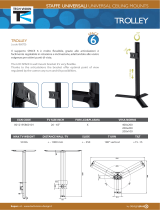
E4
OVATOR S-600 & S-400 – English
3.3 Using Floor-spikes
Ovators are fitted with floor-spikes to define the
mechanical interface with the structure of the listening
room. Floor-spikes should be adjusted to ensure that the
speakers are upright and do not rock. Use the minimum
length of floor-spike needed to hold the lock nut just
above the carpet.
Note: If Ovator loudspeakers are to be installed on a
non-carpeted floor, the floor-spikes should be used in
conjunction with Naim Floor Protectors and adjusted so
that the tip of the floor-spike extends just beyond the lock
nut. Your Naim retailer or distributor will be able to supply
Floor Protectors.
3.3.1 Adjusting S-600 Floor-Spikes
All four floor-spikes are adjustable, however adjustment of
the S-600 rear floor-spikes is easier thanks to the top access
provided by its plinth design. To adjust an S-600 rear floor-
spike first remove the locking set-screw with the 4mm Allen
key supplied. Then insert the Allen key from above to turn
3.4 Adjusting Floor-spikes
the adjustment screw clockwise to lengthen the floor-spike
and anti-clockwise to shorten the floor-spike. If necessary,
to stop the floor-spike from turning when re-tightening the
locking set-screw, insert the supplied tommy-bar in the
floor-spike through-hole. Diagram 3.4 illustrates S-600 rear
floor-spike adjustment.
Depending on the thickness of any carpet, and prior
adjustment of its rear spikes, S-600 front floor-spikes may not
need any adjustment. If adjustment is required however,
loosen the lock nut using a 13mm spanner and turn the
floor-spike as appropriate using the supplied tommy-bar
inserted in the floor-spike through-hole. Re-tighten the lock-
nut when adjustment is complete. Diagram 3.4 illustrates
front floor-spike adjustment.
3.3.2 Adjusting S-400 Floor-Spikes
To adjust an S-400 floor-spike first loosen its lock nut using
a 13mm spanner. Turn the floor-spike as appropriate using
the supplied tommy-bar inserted in the floor-spike through-
hole. Re-tighten the lock-nut when adjustment is complete.
The S-600 front floor-spike illustrated in Diagram 3.4 also
illustrates S-400 floor-spikes.
remove transit
screws
adjustment
screw
tommy-bar
through-hole
tommy-bar
through-hole
lock-nut
3.5 S-600 BMR Transit Screws
The Ovator S-600 BMR (balanced mode radiator) module
is fitted with a twin leaf-spring suspension system. The
suspension system is restrained during shipping by two
transit screws that must be released before use. The transit
screws are located on the rear face of the speaker directly
behind the BMR.
Use the supplied 5mm Allen key to unscrew the transit
screws. Remove the screws and store them safely. Diagram
3.6 illustrates removal of the transit screws.
Note: The transit screws must be replaced if the
loudspeakers are to be repacked and shipped. Tighten the
screws sufficiently to restrain the suspension system.
3.6 S-600 Transit Screw Removal










